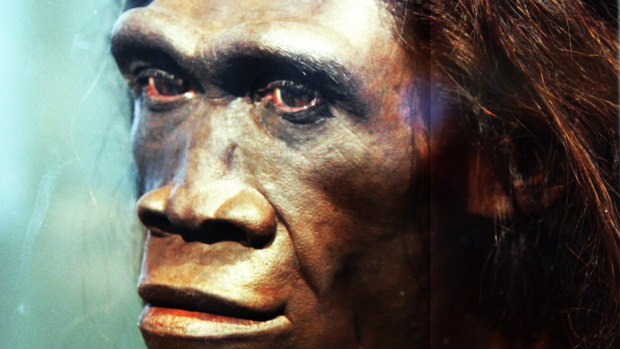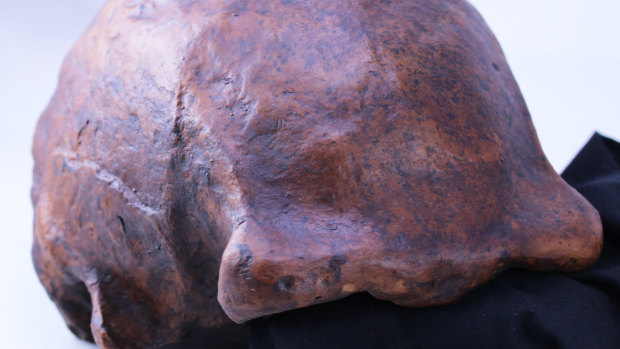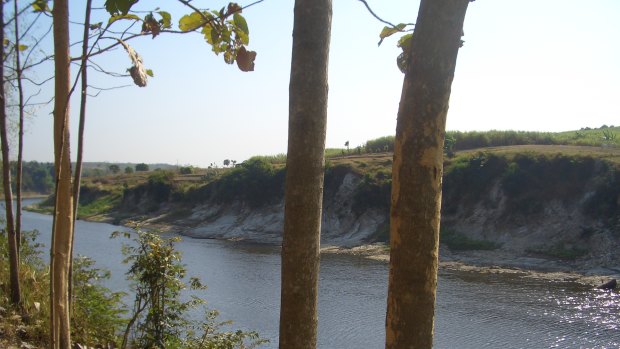By Liam Mannix
Only a few years ago, scientists believed modern humans evolved in Africa, and then left to colonise a world free of similar species.
Recently, we have learnt this is not quite right. By the time Homo sapiens left Africa, several of our less-evolved ancestors had already travelled to parts of the world.
But it was not clear if these separate species – including Homo erectus, Homo luzonensis and Homo floresiensis – were alive at the same time, or if they were alive when modern humans left Africa.
A study by Australian scientists published in Nature on Thursday goes some way to answering that.
Using a game-changing new technique that can reveal when rock was last exposed to sunlight, the team was able to confirm Homo erectus, an early human ancestor, was living in Java, Indonesia, about 100,000 years ago.
That means they were living there well before modern humans left Africa.

A model of an adult female Homo erectus, one of the first truly human ancestors of modern humans, on display at the Smithsonian Museum of Natural History in Washington DC. Credit: Reconstruction by John Gurche; photographed by Tim Evanson
But they did exist at the same time that two hobbit-like species of humans lived nearby, and probably came into contact with a third species of proto-human that was making its way towards Australia.
“For me, the story of Homo erectus is one of the most exciting parts of evolutionary research at the moment,” says Dr Ian Moffat, an archaeologist based at Flinders University who was not involved with the study.
"They managed to colonise the entire world a couple million years before modern humans even left Africa."
Digging deep into history
The new study took Macquarie University geochronologist Kira Westaway deep into Java, to a site called Ngandong, where the Solo River has carved a deep valley into the earth.
In the 1930s a team of Dutch explorers unearthed 12 fossilised skull caps buried on the river's slope.

A cast of one of the skull caps found at Ngandong.Credit: Russell L. Ciochon / University of Iowa
The skull caps were small. They suggested a species with flat faces, prominent brows and small brains. They were from a species named Homo erectus – upright man. A middle step between ape and human.
The Dutch finding filled in an important link in our evolutionary tree.
But it also raised a new question: when did evolution take this step? Was erectus in Java before modern humans, or at the same time?
Dating methods in the '30s were rudimentary. The Dutch shifted dirt all over the dig, making it very hard for modern scientists trying to date the Ngandong site.
Several dating attempts came back with estimates between 500,000 years old – 300,000 years before modern humans evolved – and 27,000 years, when modern humans lived in Australia.

The Solo River at Ngandong. The exposed river terraces where the skull caps were found can be seen on the far bank.Credit: Kira Westaway
“It really did not make sense,” says Associate Professor Westaway. “We wanted to set the record straight.”
She is an expert in luminescence dating. Some minerals, such as quartz, lose energy when exposed to sunlight. When they are buried, the energy builds up. Hit the quartz with a laser and out comes the energy, telling you how long something has been buried. “It is the coolest technique ever,” says Dr Westaway.
Using luminescence and a range of other detailed techniques, the research team came up with a new, much more accurate date for the skulls: about 117,000 years ago.
Meet the family
That happens to be a very interesting date in world history, because a lot was going on.
Homo floresiensis – nicknamed "hobbits" because they stood less than a metre tall – were living at roughly the same time on the nearby island of Flores.
Another species, Homo luzonensis, was living in the Philippines.
At the same time, a third species – known as the Denisovans – was migrating south from Siberia to Australia.
As the Denisovans spread, they mated with many other early humans, including Neanderthals.
Given erectus was around at the same time, it seems likely it too would have met the Denisovans.
"The next question is this," says Dr Westaway." Why did erectus go extinct?"